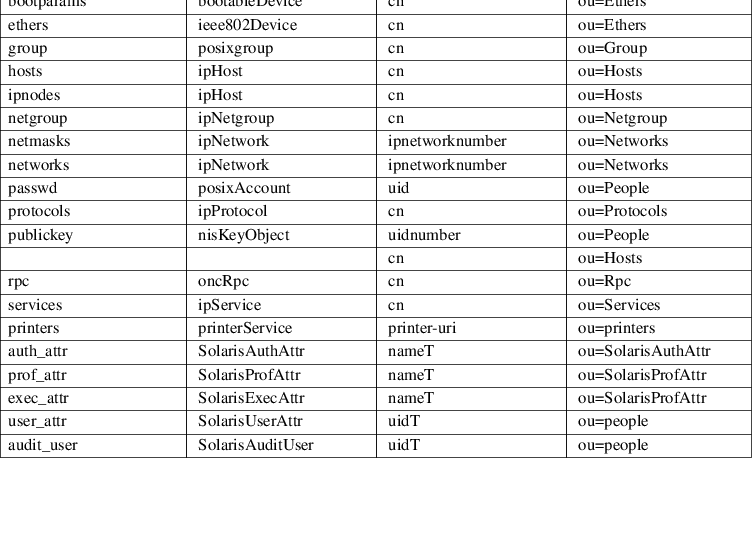NAME
ldaplist − search and list naming information from a LDAP directory using the configured profile
SYNOPSIS
/usr/bin/ldaplist [-dlv] [database [key]...]
/usr/bin/ldaplist -h
DESCRIPTION
The ldaplist utility searches for and lists the naming information from the LDAP directory service defined in the LDAP configuration files generated by ldapclient(1M) during the client initialization phase. The Solaris LDAP client must be set up in order to use this utility.
The database is either a container name or a database name as defined in nsswitch.conf(4). A container is a non-leaf entry in the Directory Information Tree (DIT) that contains naming service information. The container name is the LDAP Relative Distinguished Name (RDN) of the container relative to the defaultSearchBase as defined in the configuration files. For example, for a container named ou=people, the database name is the database specified in nsswitch.conf. This database is mapped to a container, for example, passwd maps to ou=people. If an invalid database is specified, it will be mapped to a generic container, for example, nisMapName=name).
The key is the attribute value to be searched in the database. You can specify more than one key to be searched in the same database. The key can be specified in either of two forms: attribute=value or value. In the first case, ldaplist passes the search key to the server. In the latter case, an attribute is assigned depending on how the database is specified. If the database is a container name, then the "cn" attribute type is used. If it is a valid database name as defined in the nsswitch.conf, then a predefined attribute type is used (see table below). If it is an invalid database name, then cn is used as the attribute type.
The ldaplist utility relies on the Schema defined in the RFC 2307bis, currently an IETF draft. The data stored on the LDAP server must be stored based on this Schema, unless the profile contains schema mapping definitions. For more information on schema mapping see ldapclient(1M). The following table lists the default mapping from the database names to the container, the LDAP object class, and the attribute type used if not defined in the key.

|
• |
auto_* represents auto_home, auto_direct, ... | ||
|
• |
If the key starts with a digit, it will be interpreted as an uid number. | ||
|
• |
If the key starts with a non-digit, it will be interpreted as a host name. |
The ldaplist utility supports substring search by using the wildcard "*" in the key. For example, "my*" will match any strings that starts with "my". In some shell environments, keys containing the wildcard may need to be quoted.
If the key is not specified, all the containers in the current search baseDN will be listed.
OPTIONS
The following options are supported:
|
-d |
Lists the attributes for the specified database, rather than the entries. By default, the entries are listed. | ||
|
-h |
Lists the database mapping. | ||
|
-l |
Lists all the attributes for each entry matching the search criteria. By default, ldaplist lists only the Distinguished Name of the entries found. | ||
|
-v |
Sets verbose mode. The ldaplist utility will also print the filter used to search for the entry. The filter will be prefixed with "+++". |
EXAMPLES
Example 1: Listing All Entries in the Hosts Database
example% ldaplist hosts
Example 2: Listing All Entries in a Non-Standard Database ou=new
example% ldaplist ou=new
Example 3: Finding "user1" in the passwd Database
example% ldaplist passwd user1
Example 4: Finding the Entry With Service Port of 4045 in the services Database
example% ldaplist services ipServicePort=4045
Example 5: Finding All Users With Username Starting with new in the passwd Database
example% ldaplist passwd ’new*’
Example 6: Listing the Attributes for the hosts Database
example% ldaplist -d hosts
EXIT STATUS
The following exit values are returned:
|
0 |
Successfully matched some entries. | ||
|
1 |
Successfully searched the table and no matches were found. | ||
|
2 |
An error occurred. An error message is output. |
FILES
/var/ldap/ldap_client_file
/var/ldap/ldap_client_cred
Files that contain the LDAP configuration of the client. Do not manually modify these files. Their content is not guaranteed to be human readable. To update these files, use ldapclient(1M)
ATTRIBUTES
See attributes(5) for descriptions of the following attributes:

SEE ALSO
ldap(1), ldapadd(1), ldapdelete(1), ldapmodify(1), ldapmodrdn(1), ldapsearch(1), idsconfig(1M), ldap_cachemgr(1M), ldapaddent(1M), ldapclient(1M), suninstall(1M), resolv.conf(4), attributes(5)
NOTES
RFC 2307bis is an IETF informational document in draft stage that defines an approach for using LDAP as a naming service.